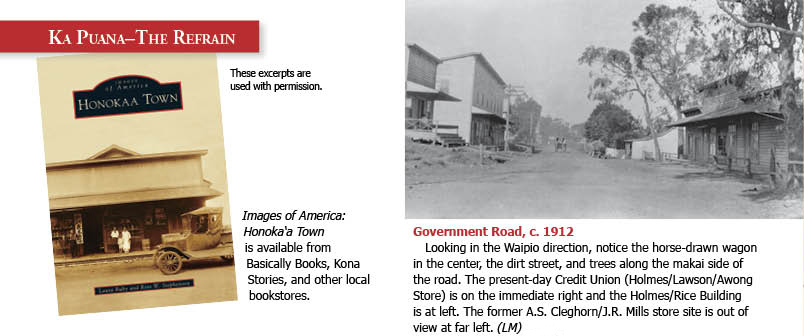
Ka Puana: Honokaa Town
Aerial Photograph of Honokaa, 1953
The first systematic aerial photography of the Hawaiian Islands was undertaken by the military for defense purposes in the 1930s. Introduction of crop dusting of fertilizer and other substances by the Honokaa Sugar Company allowed employee Paul Christensen to document sugar cane fields, mills, camps, and towns within Hamakua in the 1950s.

In the foreground are the orderly rows of Camp Eight housing. Looking toward Hilo, the Haina (Lehua) Road splits the photograph in half. Out of view to the left is the Honokaa Sugar Company Mill. To the right of the Government Road intersection and up the hill are the old Methodist church, the Hongwanji Buddhist Temple, Our Lady of Lourdes Catholic Church, and the newly opened Honokaa Hospital.
At center along Government Road are three prominent landmarks: the “Doc” Hill Theatre, the Honokaa People’s Theatre, and the Botelho Building and Garage.
On the far Hilo side, in the makai direction at upper left, is the separate Overend Camp before it was dismantled. On the mauka side (to the extreme right) are the fields and buildings of Honokaa School. (Christensen Collection, NHERC)
Government Road, c. 1912
Looking in the Waipio direction, notice the horse-drawn wagon in the center, the dirt street, and trees along the makai side of the road. The present-day Credit Union (Holmes/Lawson/Awong Store) is on the immediate right and the Holmes/Rice Building is at left. The former A.S. Cleghorn/J.R. Mills store site is out of view at far left. (LM)
Roscoe the Lion
Children from Waimea on Hawaii Island visit Roscoe the lion during World War II. Purchased as a cub from Los Angeles’s Griffith Park Zoo for $25 and later brought to Hawaii, Roscoe was the mascot for the 28th Marines 5th Marine Division at Camp Tarawa. He loved parades, lying draped on the hood of a jeep, and howling to the music. (WG)
A Family and Community Disaster
A child playing with matches started a fire that destroyed the Tanaka family laundry business and threatened other closely packed wood-framed buildings.
Fortunately, the fire station was nearby, giving firefighters the opportunity to limit the damage to one property. The instigator of the fire, soon nicknamed “Firebug,” still carries that moniker.
(Ruis/Botelho Family Collection)



